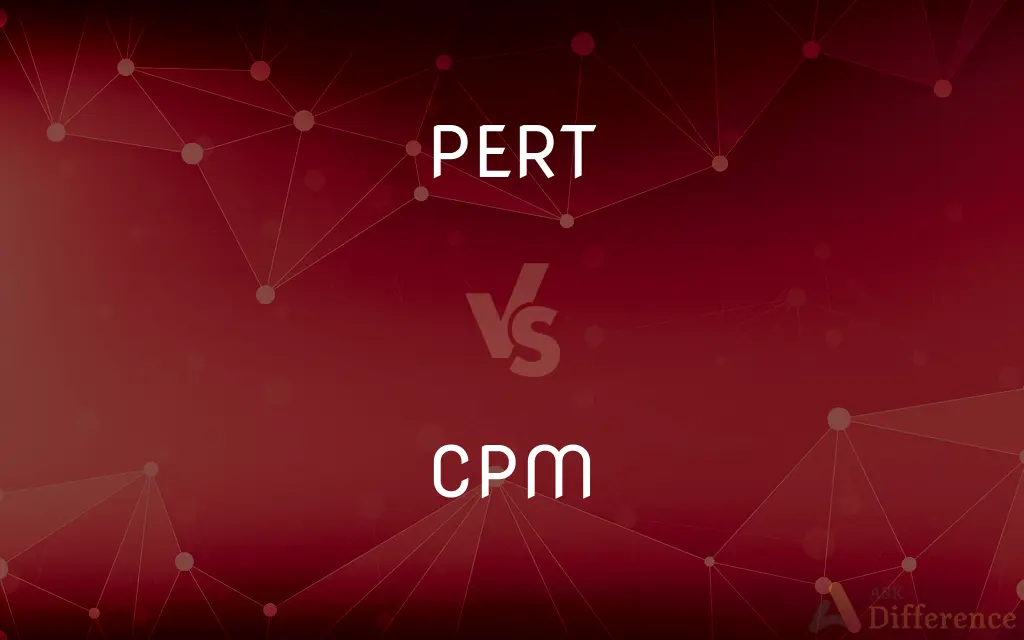PERT vs. CPM — What's the Difference?
By Tayyaba Rehman — Published on December 7, 2023
PERT (Program Evaluation Review Technique) focuses on task durations as probabilistic estimates; CPM (Critical Path Method) uses deterministic durations.

Difference Between PERT and CPM
Table of Contents
ADVERTISEMENT
Key Differences
PERT, or Program Evaluation Review Technique, and CPM, or Critical Path Method, are both project management techniques used for planning, scheduling, and controlling large-scale projects. However, their methodologies and areas of application differ significantly. PERT is typically used for projects with undefined activities, and it incorporates uncertainty by using probabilistic time estimates. On the other hand, CPM is generally applied to projects with well-defined activities and uses deterministic time estimates.
When implementing PERT, three time estimates are often provided for each activity: the optimistic, the most likely, and the pessimistic time. This allows for the calculation of expected activity durations and variances. Contrarily, CPM requires a single, deterministic time estimate for each activity, leading to a clear and fixed project duration.
Another distinguishing feature between PERT and CPM is their approach to critical path analysis. While both techniques identify the longest path in a project, which determines the shortest time to complete the entire project, CPM's deterministic nature allows for easy identification and monitoring of this path. PERT's probabilistic nature means the critical path can change based on the variability in activity durations.
Furthermore, PERT is commonly used in research and development projects, where tasks are somewhat ambiguous, and time estimates can vary. CPM, with its more rigid structure, is favored in construction projects or manufacturing, where activities have clearer beginnings, durations, and ends.
In conclusion, both PERT and CPM are vital tools in a project manager's toolkit. While they share some similarities, their distinct approaches to activity duration estimation and areas of application set them apart.
ADVERTISEMENT
Comparison Chart
Nature
Probabilistic
Deterministic
Time Estimates
Uses three (optimistic, most likely, pessimistic)
Uses a single, fixed time estimate
Project Type Suitability
R&D or projects with uncertain activities
Well-defined projects like construction
Focus
Uncertainty and risk management
Project sequencing and scheduling
Critical Path Variability
Can change due to probabilistic durations
Fixed due to deterministic durations
Compare with Definitions
PERT
Incorporates optimistic, most likely, and pessimistic times.
Using PERT, the team prepared for best-case and worst-case scenarios.
CPM
A project management technique with deterministic time estimates.
The construction project was streamlined using CPM for precise scheduling.
PERT
A project management tool using probabilistic time estimates.
For the aerospace project, the team utilized PERT to account for uncertainties.
CPM
Involves identification and monitoring of the critical path.
Through CPM, the project manager could allocate resources effectively along the critical path.
PERT
Technique considering variability in activity durations.
The developers chose PERT for the software project due to its changing requirements.
CPM
Emphasizes the shortest time to complete a project.
Using CPM, the company aimed to reduce the product launch timeline.
PERT
Helps in scheduling uncertain and unpredictable tasks.
PERT was beneficial in the research project because of the experimental nature of the tasks.
CPM
Focuses on project sequencing and scheduling.
Implementing CPM helped in identifying the project's longest path.
PERT
Useful for projects with ambiguous activities.
Given the unpredictable nature of the design phase, PERT was an ideal choice.
CPM
Ideal for well-defined projects with clear activities.
For the manufacturing setup, the team opted for CPM for its structured approach.
PERT
High-spirited, lively, or cheerful
A pert receptionist greets each client.
PERT
Impudently bold; saucy
He was pert to his teacher. She gave a pert answer.
PERT
Attractive or stylish in appearance
A pert hat.
PERT
Small or firm and well-formed
A pert nose.
PERT
(of a person) Attractive.
PERT
(of a part of the body) Well-formed; shapely.
Pert breasts
PERT
Lively; alert and cheerful; bright.
PERT
(archaic) Especially of children or social inferiors: cheeky, impertinent.
PERT
(obsolete) Open; evident; unhidden.
PERT
(obsolete) Clever.
PERT
To behave with pertness; to misbehave.
PERT
(obsolete) An impudent person.
PERT
Open; evident; apert.
PERT
Lively; brisk; sprightly; smart.
PERT
Indecorously free, or presuming; saucy; bold; impertinent.
The squirrel, flippant, pert, and full of play.
PERT
To behave with pertness.
PERT
Characterized by a lightly pert and exuberant quality;
A certain irreverent gaiety and ease of manner
Common Curiosities
Do both PERT and CPM identify a critical path?
Yes, both techniques identify the longest path in a project which determines the project's shortest completion time.
In which projects is CPM commonly applied?
CPM is commonly applied in construction or manufacturing projects.
How do PERT and CPM assist in resource allocation?
Both help in prioritizing tasks, but CPM's clear structure aids in more precise resource allocation.
How does PERT account for uncertainty in project tasks?
PERT uses three-time estimates: optimistic, most likely, and pessimistic, to account for uncertainty.
Is specialized software available for PERT and CPM?
Yes, numerous project management software options support both PERT and CPM methodologies.
Do both PERT and CPM work for long-term projects?
Yes, both techniques can be applied to both short-term and long-term projects.
What is PERT best suited for?
PERT is best suited for projects with uncertain and ambiguous activities, like R&D projects.
What is the main disadvantage of using CPM?
CPM assumes that the project is well-defined, which may not be the case for all projects.
Which method, PERT or CPM, requires more data for implementation?
PERT typically requires more data due to its three-time estimates.
How does CPM handle activity durations?
CPM uses deterministic, single time estimates for activity durations.
Is CPM more rigid than PERT in terms of project structure?
Yes, CPM is generally more structured and is used for well-defined projects.
Which technique, PERT or CPM, is more risk-oriented?
PERT is more risk-oriented due to its focus on probabilistic time estimates.
Can PERT and CPM be used together in a project?
Yes, they can be combined to take advantage of both techniques' strengths.
How do PERT and CPM handle delays in project activities?
Both techniques can adjust schedules based on delays, but PERT inherently considers variability.
How do PERT and CPM assist in project cost estimation?
Both techniques help in scheduling, which indirectly aids in estimating project costs based on durations and resource allocations.
Share Your Discovery

Previous Comparison
Departmental Store vs. Multiple Shops
Next Comparison
Saturated Compounds vs. Unsaturated CompoundsAuthor Spotlight
Written by
Tayyaba RehmanTayyaba Rehman is a distinguished writer, currently serving as a primary contributor to askdifference.com. As a researcher in semantics and etymology, Tayyaba's passion for the complexity of languages and their distinctions has found a perfect home on the platform. Tayyaba delves into the intricacies of language, distinguishing between commonly confused words and phrases, thereby providing clarity for readers worldwide.












































